Australia's smallest fish among 22 at risk of extinction within two decades
- Written by Mark Lintermans, Associate professor, University of Canberra
The tragic fish kills in the lower Darling River drew attention to the plight of Australia’s freshwater fish, but they’ve been in trouble for a long time.
Many species have declined sharply in recent decades, and as many as 90 of Australia’s 315 freshwater fish species may now meet international criteria as threatened.
No Australian fish species is yet listed officially as extinct, but some have almost certainly been lost before scientists even knew they existed. With so many species at risk, understanding which are in greatest peril is a vital first step in preventing extinctions.
This is what our new research has done. We’ve identified 20 freshwater fish species with a 50% or greater probability of extinction within the next two decades, and a further two with a 40-50% chance – unless there’s new targeted conservation action.
The Australian freshwater fishes at greatest risk of extinction.Slipping through the conservation cracks
Many small-bodied species, including Australia’s smallest fish the red-finned blue-eye, look likely to be lost within a single human generation. These fish have evolved over millions of years.
Twelve of the species identified have only been formally described in the past decade, and seven are still awaiting description.
This highlights the urgent need to act before species are listed under the national legislation that gives fishes their conservation status, and even before they’re formally described.
These processes can take many years, at which point it may be too late for some species.
More than half the species on our list are galaxiids – small, scaleless fish, that live in cooler, upland streams and lakes. Trout, an introduced, predatory species, also favour these habitats, and the trout have taken a heavy toll on galaxiids and many other small species in southern Australia.
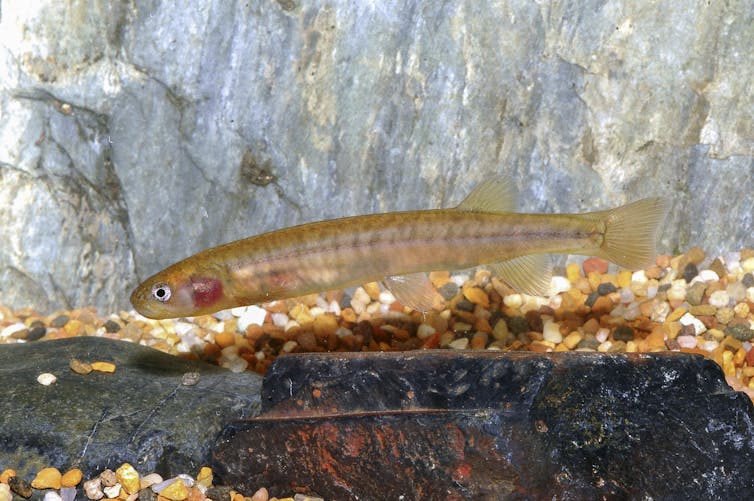 Victoria’s Shaw galaxias – one of 14 galaxias species identified at high risk of extinction.
Tarmo Raadik
Victoria’s Shaw galaxias – one of 14 galaxias species identified at high risk of extinction.
Tarmo Raadik
For example, the Victorian Shaw galaxias has been eaten out of much of its former range. Now just 80 individuals survive, protected by a waterfall from the trout below. We estimate the Shaw galaxias has an 80% chance or more of extinction within the next 20 years.
Read more: Double trouble: this plucky little fish survived Black Summer, but there's worse to come
Many galaxiids do not thrive or readily breed in captivity, so suitable trout-free streams are essential for their survival.
Improving trout management requires an urgent, sustained conservation effort, including collaborations with recreational fishers, increased awareness and changing values among government and key sectors of society.
Without this, trout will almost certainly cause many native galaxiids to go extinct.
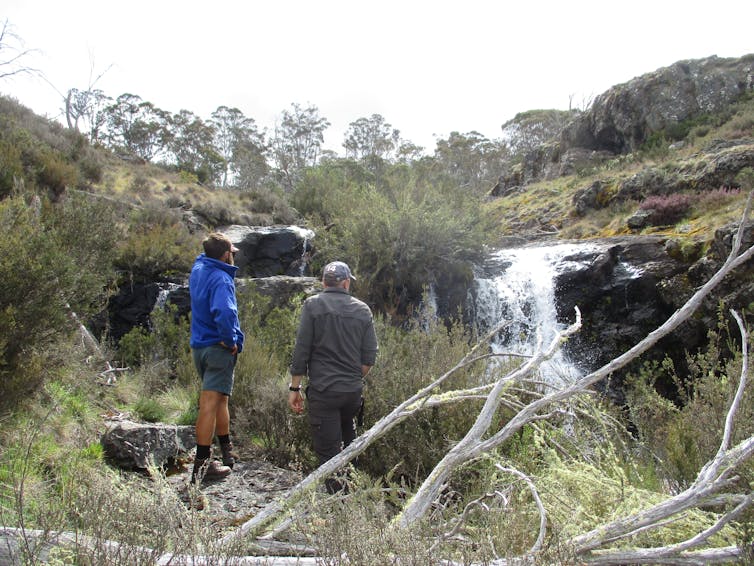 This waterfall in NSW is all that protects the last population of stocky galaxias from the predatory trout below.
Mark Lintermans
This waterfall in NSW is all that protects the last population of stocky galaxias from the predatory trout below.
Mark Lintermans
Native fish out of their natural place can also be a problem. For example, sooty and khaki grunters – native fishing species people in northern Australia have widely moved – threatening the ancient Bloomfield River cod.
One disaster can lead to extinction
All of the most imperilled species are now highly localised, which means they’re restricted to very small areas. Their distributions range from only four to 44 square kilometres.
A single catastrophic event could completely wipe out these species, such as a large bushfire that fills their streams with ash and robs them of oxygen.
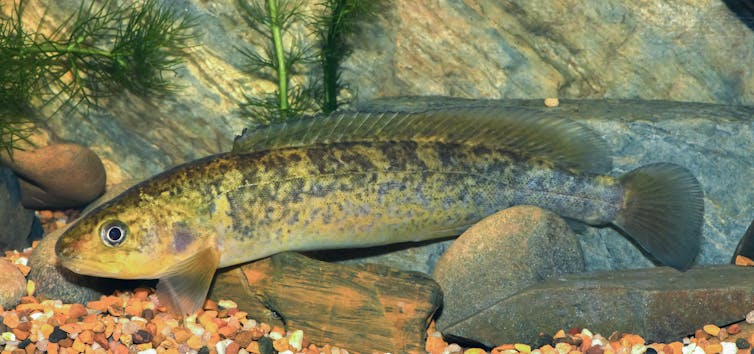 The SW Victoria River blackfish persists as three very small, isolated populations. The main threat to this species is recreational angling.
Tarmo Raadik
The SW Victoria River blackfish persists as three very small, isolated populations. The main threat to this species is recreational angling.
Tarmo Raadik
For example, until 2019 the Yalmy galaxias had survived in the cool creeks of the Snowy River National Park. But after the devastating Black Summer fires, just two individuals survived, one male and one female, in separate areas.
Millions of years of evolution could be lost if a planned reunion is too late.
One of the key steps to reduce this risk is moving fish to new safe locations so there are more populations. Researchers choose these new locations carefully to make sure they’re suitable for different species.
Climate change is another threat to all identified species, as it’s likely to reduce flows and water quality, or increase fires, storms and flooding. Many species have been forced to the edge of their range and a prolonged drought could dry their remaining habitat.
The short-tail galaxias existed in two small separated populations in creeks of the upper Tuross River Catchment, in the south coast of NSW. One stream dried in the recent drought, and the other was burnt in the subsequent fires.
Luckily the species is still hanging on in the burnt catchment, but only a single individual has been found in the drought-affected creek.
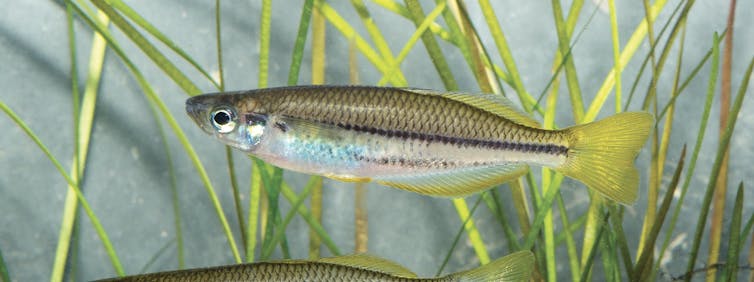 The main threat to the Daintree rainbowfish is loss of stream flow due to drought, climate change and water extraction.
Michael Hammer / Museum and Art Gallery of the Northern Territory, Author provided
The main threat to the Daintree rainbowfish is loss of stream flow due to drought, climate change and water extraction.
Michael Hammer / Museum and Art Gallery of the Northern Territory, Author provided
Unlisted, unprotected
Our study is part of a larger project to identify plants and animals at high risk of extinction.
We found the extinction risks of the 22 freshwater fish species are much higher than those of the top 20 birds or mammals, yet receive far less conservation effort.
Only three of the highly imperilled fish species are currently listed as threatened under national environmental legislation: the red-finned blue-eye, Swan galaxias and little pygmy perch.
Listing species is vital to provide protection to survivors and can prompt recovery action. Given our research, 19 fish species should urgently be added to the national threatened species list, but conservation action should start now.
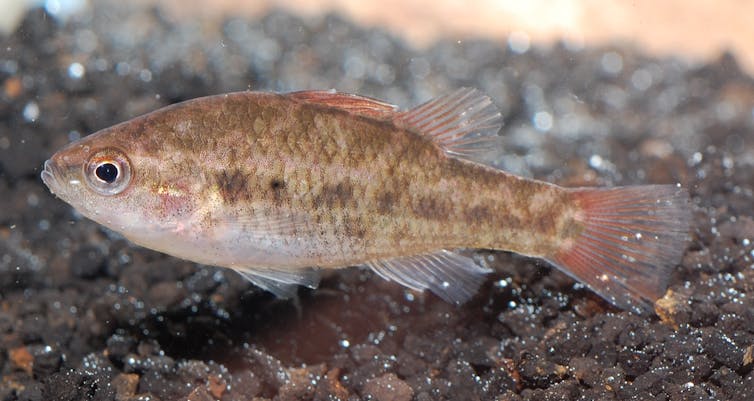 The little pygmy perch in the far south-west corner of WA is one of only three of the 22 imperilled species identified that’s formally protected under Australian laws.
Stephen Beatty/Harry Butler Institute, Murdoch University
The little pygmy perch in the far south-west corner of WA is one of only three of the 22 imperilled species identified that’s formally protected under Australian laws.
Stephen Beatty/Harry Butler Institute, Murdoch University
Small native freshwater fishes are worth saving. They play a vital role in our aquatic ecosystems, such as predating on pest insect larvae, and are part of our natural heritage.
By identifying and drawing attention to their plight, we are aiming to change their fates. We cannot continue with business as usual if we want to prevent their extinctions.
Authors: Mark Lintermans, Associate professor, University of Canberra



